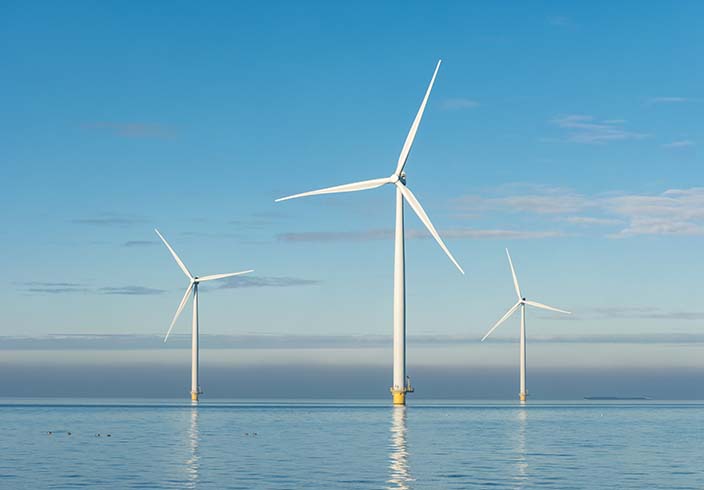Europe is facing an unprecedented energy crisis. High gas and electricity prices as well as discussions about energy security are causing uncertainty among industry and citizens alike. The good news is that the expansion of renewable energies, which has been rather stagnant so far, is being driven forward with even greater efforts – expectations regarding expansion targets have been revised upwards. Last but not least, rising prices for fossil energies are strengthening the competitiveness of renewables, which are thus becoming a future-proof alternative for the supply of natural gas.
Wind energy – both onshore and offshore – plays a central role in this development. According to forecasts by the International Energy Agency, wind energy capacities will double worldwide in the period from 2022 to 2027. In the onshore sector, the expansion is expected to exceed 570 GW. However, especially with regard to supplying industry with green electricity, there is a major challenge in the use of wind energy: its volatility. In order to be able to compensate for fluctuations, the focus must therefore be increasingly on storing wind energy and using it in a time-delayed manner – thus enabling a reliable and stable supply of renewable energies. For this reason, energy storage is a decisive factor in exploiting the full potential of wind power and reducing dependence on natural gas imports.
Electrification of industrial heat with renewable energy
When it comes to renewable energies, electricity is often the first thing that comes to mind. Here, about half of the demand in Germany is already covered by renewable sources. In the heating sector, however, the situation is different – so far only 15 per cent. Yet more than 50 per cent of final energy consumption is used for this purpose. Two thirds of this is used in industry for process heat or steam. Green heat is still the exception in this sector.
In order to successfully decarbonise their processes and end their dependence on fossil fuels such as natural gas, industry must therefore start precisely at this point and drive forward the electrification of their heat or steam supply with renewable energies. One thing is clear: without the industrial heat transition, the energy transition will not succeed.
Wind energy storage: challenges and benefits for the industry
In order to meet the increased energy demand associated with the electrification of industry – and to do so in a climate-neutral way – meeting the expansion targets is crucial. But even then, the question of supply security arises. Since wind energy can be subject to strong fluctuations in some cases. This can lead to difficulties, especially in industrial production processes, where a constant power supply is usually imperative. After all, too much wind can also become a problem: Surplus electricity from wind energy is lost when plants have to be regulated down to keep the power grid stable. The good news is that by efficiently using these production peaks, larger parts of the industry’s heating needs could be covered with CO2-neutral energy.
The use of innovative storage technologies is therefore inevitable in order to be able to use wind energy efficiently and flexibly and to completely replace fossil energy such as natural gas in the near future. In order for this to remain economically viable for the industry, the storage facilities must be able to convert the renewable energies – in this case wind energy – with as little energy loss as possible. To counterbalance longer periods of power deficit, the ability to discharge over several hours or even days is also essential.
Battery storage as a solution for storing wind energy
Thermal energy storage systems such as the ThermalBattery® from ENERGYNEST are a cost-effective solution. As a link between the electricity and heating markets, they ensure that companies can use green heat or green steam from renewable energies for their processes, consequently driving the move away from natural gas. With an efficiency of around 95 per cent, they are able to store energy from production peaks and release it as heat or steam at a later date. Storing wind energy in batteries thus enables a flexible and clean energy supply in industry – around the clock.
Storing wind energy – how electricity producers and grid operators benefit
However, storing wind energy does not only offer significant advantages for industry. Through the possibility of storage and subsequent conversion into heat, surplus energy can be shifted from electricity supply to heat supply with the help of sector coupling. For operators of onshore or offshore wind farms, this means maximising their revenues, reducing connection costs and generating additional income from heat supplies.
Furthermore, thanks to storage technologies, peaks in energy production can be balanced out. This benefits the grid operators in particular, as it allows the existing grids to be used more efficiently – the pressure to push ahead with grid expansion quickly is reduced. In addition, fewer costs are incurred because the effort required to stabilise the electricity grids is significantly reduced.
Thus, in addition to a climate-neutral and stable heat and steam supply in industry, heat storage systems also provide significantly more flexibility in the entire energy supply system – and are therefore becoming a key technology for the energy transition.
Are you interested in ENERGYNEST, or have any questions regarding our thermal energy storage solutions or our applications for your specific industry?
Don’t hesitate to drop us a line.



